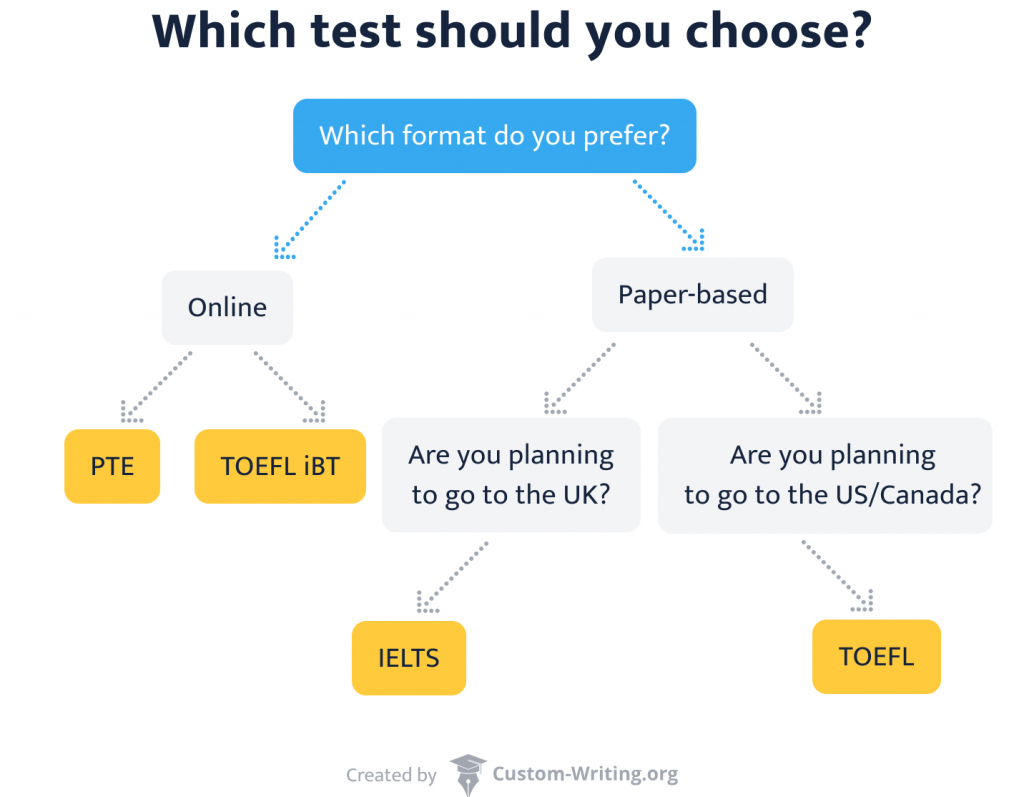Do you want to live or study in an English-speaking country, but English is not your first language? You most likely need to pass a proficiency test. It aims to assess your reading, writing, listening, and speaking skills.
Which test to take? That’s a good question. It all depends on your preferences and your goals. Proficiency tests have similar structures, but they differ in duration, content, and fees. Our custom writing team wrote this article to help you understand the difference between IELTS, TOEFL, and PTE. Here you will find:
- detailed information about the three most popular proficiency tests;
- tips on how to choose which exam to take.
📊 PTE vs. IELTS vs. TOEFL: An Overview
Nowadays, the most widely-spread proficiency tests are PTE, IELTS, and TOEFL. Their certificates are recognized almost all over the world. However, IELTS is preferable in the countries of the Commonwealth. TOEFL is associated with US universities, but it’s also accepted in Canada, Australia, and the UK.

Here’s some basic information about these tests:
- PTE stands for the Pearson Test of English Academic. It is a computer-based exam. Pearson Inc. launched it in 2009.
- TOEFL means the Test of English as a Foreign Language. Just like PTE, it is conducted online. But you may also complete it in writing if you don’t have access to the Internet. It was launched back in1964, and the Educational Testing Service administrates it.
- IELTS is a shortened form of the International English Language Testing System. Unlike two other tests, it is predominantly a paper-based exam, though it’s also possible to take it online. It was launched in 1989 by the British Council, Cambridge English Language Assessment, and the International Development Program of Australian Universities and Colleges.
Now let’s dig deeper into each of these tests and see which one suits you best.
🖥️ PTE: An Overview with Pros & Cons
- Duration. It may take you up to 3 hours to pass this exam. Here is how long each of its parts takes:
- 77-93 minutes;
- 32-40 minutes;
- 45-57 minutes.
You may also have a 10-minute break, but it is optional.
- Format. You can only take it via the Internet.
- Structure. PTE consists of 3 parts: speaking and writing, reading, and listening.
- Speaking and Writing Section. In the first part of the test, you need to:
- introduce yourself;
- complete different tasks (repeating sentences, answering questions, describing images.) Usually, students have 10-40 seconds for preparation before each assignment;
- write a text summary (you will be given 10 minutes)
- compose an essay (you should write a 200-300-word text for 20 minutes.)
- Reading Section. During this part, you should fill in the blanks, complete multiple-choice and single-answer assignments, and re-order paragraphs.
- Listening Section. Here, students are expected to answer the questions after watching video clips and listening to audio recordings. They will be played only once, and you may take notes.
- Speaking and Writing Section. In the first part of the test, you need to:
- Score. PTE utilizes the Global Scale of English. It means that your answers are scored from 10 to 90. A minimum score is 55-60. Some universities may accept 50.
- Fee. The price depends on the country where you are going to pass the exam. In general, it ranges from $170 to $290.
- Validity. The majority of universities all around the globe accept PTE Academic. Even such prestigious educational establishments as Harvard Business School and Yale recognize PTE certificates.
Now let’s find out the advantages and disadvantages of PTE Academic.
✏️ IELTS: All You Need to Know
- Duration. The exam lasts for 2 hours and 45 minutes. Each of its parts takes:
- 30 minutes;
- 1 hour 20 minutes;
- 11-14 minutes.
You should complete the first two parts on the same day. But you have a week before and after this date to pass the third part.
- Format. There are two ways to take this test:
- on paper (a primary variant)
- on the computer (an additional option.)
- Type. There are two types of IELTS:
- IELTS Academic;
- IELTS General Training.
Make sure that your preparation corresponds to the chosen exam type.
- Structure. The exam is divided into four parts: listening, reading, writing, and speaking.
- Listening. Students should listen to 4 audio recordings and answer 40 questions. You may take notes while listening. Then you will have 10 minutes to complete the answer sheet. Be careful with your spelling and grammar.
- Reading. You will have to read some passages from books, magazines, or newspapers and answer questions. This section lasts for 60 minutes.
- Writing. This part differs in IELTS Academic and IELTS General. In both cases, you need to complete two writing tasks. You will be given 60 minutes.
- Speaking. It consists of 3 parts:
- introducing yourself;
- speaking on a given topic;
- answering questions on the issue from part 2.
- Score. Your skills will be measured against the band scores. The scale ranges from 0 to 9. It would be best if you got at least 6.0 or 6.5. Some universities may accept 5.0 or 5.5.
- Fee. The price varies from country to country. In general, it ranges from $170 up to $300. In some countries, the costs slightly differ for paper-based and computer-based tests.
- Validity. Its certificates are accepted in universities, colleges, schools, and immigration agencies in the UK, Canada, New Zealand, Australia, and many other countries.
Now it’s time to find out IELTS’s advantages and disadvantages:
✍️ TOEFL: A Comprehensive Overview
- Duration. It lasts for nearly 3 hours and 30 minutes. Here’s the duration of each part:
- 54–72 minutes;
- 41–57 minutes;
- 17 minutes;
- 50 minutes.
There’s also a 10-minute break between parts 2 and 3.
- Format. This exam comes in 2 forms:
- TOEFL iBT (Internet-based test);
- TOEFL Paper-delivered test.
- Structure. Just like IELTS, TOEFL consists of four sections: reading, listening, speaking (TOEFL iBT only), and writing.
- Reading. Be ready to read the abstracts from university-level textbooks and answer the questions. There is also a glossary for you to help define uncommon words.
- Listening. Here, you are expected to listen to 2 types of recordings: a lecture and a conversation. Then, you answer the questions. It’s allowed to take notes while listening.
- Speaking. During this part, you should answer 4 questions. You’ll speak through a microphone. Students are given 15-30 seconds to prepare before answering each question. Pay attention that the TOEFL Paper-delivered Test doesn’t have the Speaking section.
- Writing. There will be two assignments: to write a summary and an essay.
- Score. TOEFL uses a scale from 0 to 120 to ensure the general grade. Each section is assessed from 0 to 30. A minimum general score should be 70-80. Some universities may accept 65.
- Fee. Just like with PTE and IELTS, the price depends on the chosen location. In general, the cost varies from $185 to $300. But you may pay additional money for rescheduling, late registration, or score review.
- Validity. The certificates are accepted by companies, educational establishments, and immigration agencies in more than 150 countries. Australia, the USA, New Zealand, Canada, and the UK are on the list.
And finally, TOEFL’s advantages and disadvantages:
We hope you have found out the essentials along with the pros and cons of all three proficiency tests. Let’s recap your options:
- If you prefer the virtual world to the real one, PTE will be a good choice.
- Are you fond of RP and dream of studying in the UK? IELTS is your option.
- Choose TOEFL if you aim to move to the USA or Canada.
As you can see, everything depends on your goals and preferences. Have you already decided which is easier: TOEFL or IELTS, or maybe you are for PTE? Let us know in the comments!
Further reading:
- How to Study Effectively: 12 Study Tricks to Save Time
- 15 Best Free Language Learning Websites and Apps
- What are the Benefits of Learning a Second Language: Statistics & Facts
- Improve Your English: Learning Tips & Materials
🔍 References
- What Is IELTS?: IELTS.org
- Why PTE: Pearson English Language Test
- Why Choose the TOEFL Test?: ETS.org
- Top 5 Benefits of Preparing for the IELTS Test: edX
- IELTS vs. TOEFL vs. PTE. Which English Test Should I Take in 2025?: Masters Portal
- University Admissions: Why Take the TOEFL?: Top Universities
- TOEFL vs. IELTS for English Proficiency Exams: World Education Services



![Unexpected Career Tips from Celebrities [2025 Edition]](https://custom-writing.org/blog/wp-content/uploads/2021/01/Career-tips-title-1-284x153.jpg)






![Internship Essay: Example & Complete Writing Guide [2025]](https://custom-writing.org/blog/wp-content/uploads/2020/12/internship-student-e1565190155561-284x153.jpg)
